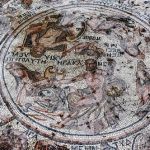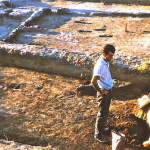 Mysteries
Mysteries  Mysteries
Mysteries  History
History 10 Surprising Stories About the Texas Rangers
 Humans
Humans 10 Philosophers Who Were Driven Mad by Their Own Theories
 Miscellaneous
Miscellaneous 10 Video-Game-Worthy Weapons and Armors from History
 Weird Stuff
Weird Stuff 10 Psychics Who Accurately Predicted Wartime Events
 The Arts
The Arts 10 Pieces of Art Inspired by a Broken Heart
 Health
Health 10 Science Fiction-Sounding New Medical Treatments
 History
History 10 Surprising Facts About the Father of Submarine Warfare
 Space
Space Ten Astonishing New Insights into Alien Worlds
 Weird Stuff
Weird Stuff 10 Bizarre Summer Solstice Rituals Still Practiced Today
 Mysteries
Mysteries Top 10 Haunting Facts About the Ghost Ship MV Alta
 History
History 10 Surprising Stories About the Texas Rangers
 Humans
Humans 10 Philosophers Who Were Driven Mad by Their Own Theories
Who's Behind Listverse?

Jamie Frater
Head Editor
Jamie founded Listverse due to an insatiable desire to share fascinating, obscure, and bizarre facts. He has been a guest speaker on numerous national radio and television stations and is a five time published author.
More About Us Miscellaneous
Miscellaneous 10 Video-Game-Worthy Weapons and Armors from History
 Weird Stuff
Weird Stuff 10 Psychics Who Accurately Predicted Wartime Events
 The Arts
The Arts 10 Pieces of Art Inspired by a Broken Heart
 Health
Health 10 Science Fiction-Sounding New Medical Treatments
 History
History 10 Surprising Facts About the Father of Submarine Warfare
 Space
Space Ten Astonishing New Insights into Alien Worlds
 Weird Stuff
Weird Stuff 10 Bizarre Summer Solstice Rituals Still Practiced Today
Top 10 Mysterious Archaeological Discoveries That Still Baffle Scientists
Archaeology is a field that has always captured the imagination and curiosity of people worldwide. From Stonehenge to the Tomb of King Tutankhamun, these discoveries fascinate us with their enigmatic history and remarkable complexity. However, some archaeological discoveries still baffle scientists and historians, inspiring wild theories and speculation.
Let’s explore the top ten most mysterious archaeological discoveries that have left experts scratching their heads.
Related: Top 10 Rare Archaeological Finds From France
10 The Nazca Lines
The Nazca Lines are a series of massive ancient geoglyphs etched into the desert floor of the Nazca plateau in southern Peru. These designs cover an area of roughly 19 square miles (50 square kilometers). They are believed to have been created by the Nazca people between 500 BC and AD 500. The figures include animals such as birds, spiders, and monkeys, as well as geometric shapes and humanoid figures.
Despite extensive research, scientists are still baffled by the purpose behind the Nazca Lines. One theory is that the lines served as an astronomical calendar, with certain figures aligning with the positions of celestial bodies at certain times of the year. Another theory suggests that the designs were used in religious rituals or as a form of pilgrimage.
One of the most intriguing aspects of the Nazca Lines is how the Nazca people created such large, intricate designs with such precision without modern technology. The designs are so large that they can only be fully appreciated from the air, leading some to speculate that the Nazca people possessed some form of hot-air balloon or glider.
9 The Voynich Manuscript
The Voynich Manuscript is a book that has mystified scholars for centuries. Written in an unknown language with an alphabet of its own and filled with perplexing illustrations of plants, astronomical diagrams, and figures, the manuscript has stumped cryptographers, historians, and linguists alike since its discovery in 1912.
The manuscript has been subjected to numerous scientific tests and analyses, yet no one has been able to unravel its true meaning or purpose. Many theories abound, from it being a medical or herbal text to an alchemical or astronomical work. Some even speculate that the book is a hoax or an elaborate cipher.
In 2019, researchers claimed they had made a breakthrough and decoded a small portion of the text using artificial intelligence. However, the results are still under scrutiny and have yet to be verified. The book continues to captivate the imagination of scholars, linguists, and enthusiasts worldwide, with many still pondering the meaning and purpose behind its mysterious text and illustrations.
8 The Antikythera Mechanism
The Antikythera Mechanism is an ancient Greek analog computer discovered in the Antikythera shipwreck off the coast of Greece in 1901. The mechanism, believed to have been constructed in the 2nd century BC, is considered one of the most mysterious archaeological discoveries of all time due to its complexity and the mystery surrounding its purpose.
The Antikythera Mechanism is a complex device comprising at least 30 bronze gears and other components. The mechanism was operated by turning a hand crank to set the gears in motion. Despite extensive study, the purpose of the Antikythera Mechanism remains a mystery. One theory is that it was used for astronomical and astrological purposes, while others believe that it was used to track the cycles of the Olympic games. However, no definitive explanation has been agreed upon by scientists.
Recent discoveries have shed some light on the Antikythera Mechanism. In 2006, X-ray imaging and 3D computer modeling revealed previously unknown features of the mechanism, including two hidden dials. These new findings have helped researchers better understand the device’s inner workings. Still, the mechanism’s ultimate purpose remains a mystery that continues to baffle scientists.
7 Stonehenge
Stonehenge is a fascinating monument located in England that has been shrouded in mystery for centuries. The site comprises a circle of massive standing stones weighing up to 25 tons (22.7 tonnes), placed there over 5,000 years ago. The question of why and how these stones were arranged in such a way has puzzled scientists and archaeologists for generations.
Many theories have been proposed to explain Stonehenge’s purpose, from an astronomical observatory to a religious site or burial ground. Some even speculate that the stones possess mystical or healing properties. Despite the many attempts to solve the mystery, none have been completely verified.
However, in 2020, researchers made a fascinating discovery that shed new light on the site. They uncovered a circle of pits surrounding the monument, which may have held large wooden posts, leading to the theory that the site was much larger and more complex than previously thought.
But the mystery surrounding Stonehenge grows deeper with each passing year. Some have even suggested that extraterrestrial beings constructed the site and that the stones possess otherworldly powers. While these theories may seem far-fetched, they add to the intrigue surrounding one of human history’s most enigmatic and perplexing monuments.
6 The Crystal Skulls
Ah, the infamous Crystal Skulls! These mysterious artifacts have been the subject of much speculation and intrigue. These skulls, carved out of clear or milky quartz, are believed to have originated from ancient Mesoamerican cultures, such as the Aztec or Maya, and were likely used for spiritual or ceremonial purposes.
But the real question is, do these skulls possess supernatural powers or otherworldly abilities? Some believe the skulls can heal, ward off evil spirits, or predict the future. Others have speculated that the skulls were brought to Earth by extraterrestrial beings.
Now, I’m not one to believe in aliens or supernatural powers, but these skulls have certainly captured the imagination of people worldwide. In fact, you might remember the infamous Indiana Jones movie featuring these skulls. Let’s just say it wasn’t the greatest film in the series. But all jokes aside, the Crystal Skulls remain one of history’s most intriguing and enigmatic archaeological discoveries.
5 The Moai of Easter Island
The Moai of Easter Island are some of Earth’s most striking and mysterious archaeological discoveries. These massive statues, carved from volcanic rock and weighing up to 75 tons (68 tonnes), were created by the Rapa Nui people of Easter Island between 1100 and 1680.
One of the most baffling aspects of the Moai is how the Rapa Nui people could carve and transport these enormous statues with limited resources. The statues are located all over the island, and some even stand in a row facing the ocean.
The purpose of the Moai is a subject of speculation. Some experts believe that the statues were erected to honor ancestors or as a way to communicate with the gods. Others argue that Rapa Nui society used them as a symbol of power and status. Still, others suggest that they were created to help guide navigators at sea.
In recent years, researchers have discovered that the statues were transported using a system of ropes and wooden sleds and that the Rapa Nui people had a sophisticated understanding of engineering and construction. These findings have helped to dispel some of the myths surrounding the Moai and have provided a deeper understanding of this fascinating civilization.
4 The Great Pyramids of Giza
Hold onto your hats, folks, because we’re talking about one of the most awe-inspiring archaeological discoveries of all time—the Great Pyramids of Giza! These majestic structures in Egypt were built over 4,500 years ago and still leave us in awe today.
The Great Pyramids were constructed as tombs for pharaohs and their consorts, but how these massive structures were built with such precision and accuracy remains a mystery. Some have speculated that they were built with the help of advanced technology or even extraterrestrial assistance.
But that’s not all; some believe they were designed as a map of the stars or as a cosmic energy generator. Others speculate that the pyramids were built to harness the power of the earth’s magnetic fields or to store vast amounts of ancient knowledge.
While these theories may seem a bit far-fetched, the sheer scale and complexity of the Great Pyramids have led many to believe that they are more than just tombs. Recent discoveries, such as hidden chambers and tunnels within the pyramids, have only added to the mystery surrounding them.
3 The Baghdad Battery
The Baghdad Battery is a remarkable archaeological discovery that intrigues scientists and historians alike. This ancient device, believed to date back to 250 BC, comprises a clay jar, a copper cylinder, and an iron rod arranged to produce a small electric current when filled with an acidic substance.
Despite being a simple device, its true purpose remains shrouded in mystery. Scholars have put forth various theories over the years, suggesting that the device was used for electroplating, as a medical instrument, or for religious ceremonies. Moreover, some scholars have posited that the Baghdad Battery was part of a larger, more complex system lost to history. Others have speculated that it was used as an early electrotherapy, treating illnesses with electricity.
The Baghdad Battery has also inspired wild and outlandish theories, such as the idea that it was used to communicate with extraterrestrial beings. Regardless of its true purpose, the Baghdad Battery remains an enigmatic and remarkable artifact that attests to the ingenuity and resourcefulness of ancient civilizations. Its continued study and exploration may provide us with insights into antiquity’s technological advancements and societal practices.
2 The Piri Reis Map
The Piri Reis Map is an ancient map discovered in the early 20th century and is believed to date back to the early 16th century. What makes the Piri Reis Map so remarkable is that it depicts the coastlines of Europe, Africa, and South America with a level of accuracy that was seemingly impossible at the time of its creation. The map is also notable for including the coastline of Antarctica, a continent that would not be discovered until centuries later.
The origins of the Piri Reis Map are shrouded in mystery, and its purpose remains a subject of much debate. Some experts believe it was created as a navigational aid for sailors, while others suggest it was intended for ceremonial or religious purposes.
However, what makes the Piri Reis Map truly intriguing are the enigmatic markings that appear on it. Some have suggested that the markings are evidence of an ancient civilization possessing advanced knowledge of mathematics and astronomy. In contrast, others speculate they are a code or a secret language.
Whether the Piri Reis Map is evidence of ancient knowledge or an elaborate hoax remains to be seen. Nevertheless, this ancient artifact continues to captivate people’s imaginations worldwide and remains one of the most exciting and mysterious archaeological discoveries.
1 The Tomb of King Tutankhamun
The discovery of the Tomb of King Tutankhamun in 1922 was a historic moment in the field of archaeology. The young pharaoh’s tomb was uncovered in the Valley of the Kings in Egypt, and it was found to contain a treasure trove of ancient artifacts, including his famous golden mask.
Despite the wealth of knowledge that has been gained from the tomb’s discovery, the mystery surrounding the death of King Tutankhamun remains unsolved. Some experts believe he died from an injury sustained during a hunting accident, while others suggest he was murdered.
Despite these advances, the mystery and allure of the Tomb of King Tutankhamun remain as strong as ever. The intricate carvings, elaborate artifacts, and enigmatic history of the young pharaoh continue to capture people’s imaginations worldwide.
In recent years, discoveries have been made that shed light on the life and death of King Tutankhamun. For instance, the discovery of his parentage, which had long been a subject of debate, has been confirmed through genetic analysis. A recent study of his mummified remains suggests that he suffered from a rare genetic disorder that likely contributed to his death.








